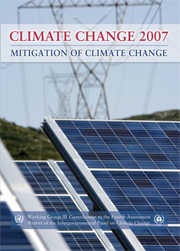 Climate Change 2007 - Mitigation of Climate Change
Climate Change 2007 - Mitigation of Climate Change Book contents
- Frontmatter
- Contents
- Foreword
- Preface
- Summary for Policymakers
- Technical Summary
- 1 Introduction
- 2 Framing issues
- 3 Issues related to mitigation in the long term context
- 4 Energy supply
- 5 Transport and its infrastructure
- 6 Residential and commercial buildings
- 7 Industry
- 8 Agriculture
- 9 Forestry
- 10 Waste management
- 11 Mitigation from a cross sectoral perspective
- 12 Sustainable Development and mitigation
- 13 Policies, instruments and co-operative agreements
- Annex I Glossary
- Annex II Acronyms, abbreviations and chemical compounds
- Annex III List of contributors
- Annex IV List of reviewers
- Index
3 - Issues related to mitigation in the long term context
- Frontmatter
- Contents
- Foreword
- Preface
- Summary for Policymakers
- Technical Summary
- 1 Introduction
- 2 Framing issues
- 3 Issues related to mitigation in the long term context
- 4 Energy supply
- 5 Transport and its infrastructure
- 6 Residential and commercial buildings
- 7 Industry
- 8 Agriculture
- 9 Forestry
- 10 Waste management
- 11 Mitigation from a cross sectoral perspective
- 12 Sustainable Development and mitigation
- 13 Policies, instruments and co-operative agreements
- Annex I Glossary
- Annex II Acronyms, abbreviations and chemical compounds
- Annex III List of contributors
- Annex IV List of reviewers
- Index
Summary
EXECUTIVE SUMMARY
This chapter documents baseline and stabilization scenarios in the literature since the publication of the IPCC Special Report on Emissions Scenarios (SRES) (Nakicenovic et al., 2000) and Third Assessment Report (TAR, Morita et al., 2001). It reviews the use of the SRES reference and TAR stabilization scenarios and compares them with new scenarios that have been developed during the past five years. Of special relevance is how ranges published for driving forces and emissions in the newer literature compare with those used in the TAR, SRES and pre-SRES scenarios. This chapter focuses particularly on the scenarios that stabilize atmospheric concentrations of greenhouse gases (GHGs). The multi-gas stabilization scenarios represent a significant change in the new literature compared to the TAR, which focused mostly on carbon dioxide (CO2) emissions. They also explore lower levels and a wider range of stabilization than in the TAR.
The foremost finding from the comparison of the SRES and new scenarios in the literature is that the ranges of main driving forces and emissions have not changed very much (high agreement, much evidence). Overall, the emission ranges from scenarios without climate policy reported before and after the SRES have not changed appreciably. Some changes are noted for population and economic growth assumptions. Population scenarios from major demographic institutions are lower than they were at the time of the SRES, but so far they have not been fully implemented in the emissions scenarios in the literature. All other factors being equal, lower population projections are likely to result in lower emissions.
- Type
- Chapter
- Information
- Climate Change 2007 - Mitigation of Climate ChangeWorking Group III contribution to the Fourth Assessment Report of the IPCC, pp. 169 - 250Publisher: Cambridge University PressPrint publication year: 2007
- 4
- Cited by
